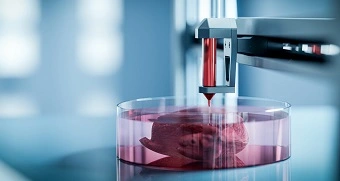Revolutionizing Medicine: The Dawn of 3D Bioprinting
20 May 2024 • by Natalie Aster

The advent of 3D bioprinting is slated to revolutionize the medical field, offering unprecedented opportunities for patient care and treatment. This cutting-edge technology leverages the principles of 3D printing to develop complex biological structures, which have profound implications for tissue engineering, personalized healthcare, and regenerative medicine. By precisely layering bioinks made from living cells, 3D bioprinting can fabricate tissues and potentially entire organs, transforming how we approach medical treatments.
The Mechanics of 3D Bioprinting: Precision & Innovation
3D bioprinting operates by depositing layers of bioinks to form 3D structures. These bioinks are usually composed of biomaterials, living cells, and growth factors, which mimic the natural environment of tissues. The process begins with imaging technologies such as CT and MRI scans to create a detailed blueprint of the desired organ or tissue. Leveraging this data, bioprinters can then precisely place cells in specific patterns, layer by layer, to form the intricate architecture of tissues.
Regenerative Therapies: Healing from Within
One of the key promising areas for 3D bioprinting lies in regenerative medicine. This field focuses on replacing or repairing damaged organs and tissues, and bioprinting presents a sophisticated method for creating these replacements. For example, bioprinted cartilage for joint repairs, skin grafts for treating burns, and even heart valves are being developed. These bioprinted structures can be customized to match the patient’s cells, diminishing the risk of rejection and fostering integration with existing tissues.
Personalized Medicine: Treatments Catering to Specific Needs
Personalized medicine aims to customize healthcare plans to address individual patient characteristics, and 3D bioprinting emerges as a game-changer in this regard. By employing a patient’s own cells, bioprinted tissues can be designed to match the individual’s genetic makeup and specific needs. This level of customization can enhance the effectiveness of treatments, reduce adverse reactions, and provide solutions that are precisely tailored to each patient’s condition.
Drug Testing & Development: A New Paradigm
The pharmaceutical industry stands to benefit significantly from 3D bioprinting technology. Traditional drug testing approaches commonly rely on animal models or simplistic cell cultures, which might not accurately reflect human responses. Bioprinted tissues offer a more reliable alternative, allowing for the creation of human-like tissue models that can be harnessed for drug testing. This can encourage the development of novel drugs, decrease the use of animal-based testing, and improve the safety and efficacy of pharmaceuticals.
Organ Transplantation: The Ultimate Frontier
Perhaps the most groundbreaking potential of 3D bioprinting is in the organ transplantation realm. The shortage of donor organs is a critical issue worldwide, and bioprinting suggests a viable solution. Researchers are working towards the ability to print entire organs, such as hearts, livers, and kidneys, utilizing a patient’s own cells. Whilst still in the experimental stage, this technology could eventually obviate the need for organ donors and the associated complications of transplant rejection.
Challenges & Future Horizons
Despite its vast potential, 3D bioprinting faces several challenges. Technical hurdles include the need for advanced bioprinters capable of high precision and the development of suitable bioinks that can support complex tissue structures. Additionally, ethical and regulatory considerations must be addressed to ensure the efficacy and safety of bioprinted tissues and organs.
Looking forward, continued research and innovation are essential to overcoming these challenges. Collective efforts between engineers, scientists, and healthcare professionals will drive the advancement of bioprinting technologies. As these hurdles are cleared, the broad acceptance of 3D bioprinting in clinical settings is likely to transform the healthcare realm, giving new hope to patients around the globe.
Concluding Thoughts: A New Era in Healthcare
3D bioprinting is set to revolutionize medical practices, providing innovative approaches in customized treatments, regenerative therapies, organ transplantation, and tissue engineering. As the technology keeps evolving, it holds the potential to resolve some of the most critical issues in healthcare, finally leading to better patient outcomes and fostering breakthroughs in medical science. The future of medicine is being printed layer by layer, and it is a future filled with unprecedented possibilities.
Product Details:
3D Bioprinting Market by Component (3D bioprinters (Microextrusion, Inkjet, Laser), Bioinks, Software, Consumable), Material (Hydrogels, ECM), Application(Research (Regenerative Medicine, 3D cell Culture), Clinical (Skin, Bone)) - Global Forecast to 2029
Published: May 2024
Pages: 454
CONTACTS
The Market Publishers, Ltd.
Natalie Aster
Tel: +357 96 030922
[email protected]
MarketPublishers.com
Analytics & News
